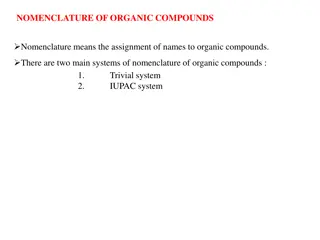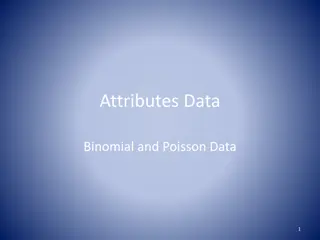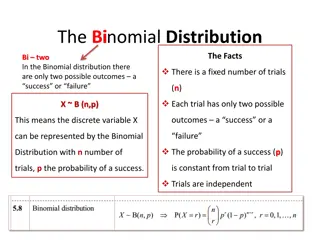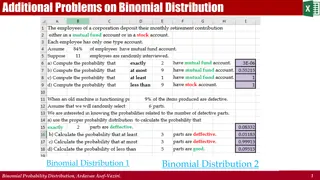Understanding Tumor Classification and Nomenclature in Pathology
This slideshow provides an overview of tumor classification, nomenclature, and key concepts in pathology. It covers the definitions of neoplasm, tumor, and oncology, the classification of tumors into benign and malignant categories, as well as the importance of stroma in tumor behavior. It also expl
2 views • 61 slides
Understanding Binomial Distribution in R Programming
Probability distributions play a crucial role in data analysis, and R programming provides built-in functions for handling various distributions. The binomial distribution, a discrete distribution describing the number of successes in a fixed number of trials, is commonly used in statistical analysi
14 views • 30 slides
Introduction to Theory of Machine Unit I: Simple Mechanisms
Explore the fundamentals of Theory of Machine (MEC-201A) Unit I with Dr. Sandeep, Assistant Professor in the Mechanical Engineering Department. Learn about the introduction to machines, motion classification, kinematic links, nomenclature, constrained motion, kinematic pairs, kinematic chains, and m
8 views • 32 slides
Understanding Binomial Experiments and Probability Calculations
Binomial experiments have specific conditions to be met, such as fixed trials and two outcomes. Symbols and notations help represent these experiments. Calculating probabilities of successes in trials involves using functions like binompdf and binomcdf. Examples like determining defective switches o
11 views • 8 slides
Plant Classification and Nomenclature Explained
Understanding plant classification through taxonomy, identification, and naming processes. Learn about the botanical structures such as roots, venation patterns, flowers, and vascular bundles. Explore the principles of binomial nomenclature, genus, and species differentiation. Discover the diverse s
1 views • 159 slides
Understanding Negative Binomial Distribution in Probability Theory
Exploring the Negative Binomial Distribution in probability theory can help us analyze scenarios where multiple trials are needed to achieve a certain number of successes. This distribution provides insights into situations like playing carnival games or conducting independent trials with varying su
0 views • 39 slides
Advanced Detector Nomenclature and Proposed Segmentation System
This content provides detailed information on detector nomenclature, parts, and a proposed segmentation system for advanced spectrometers. It includes visuals and explanations of ring, septant, coil, and segment identification within the detector, offering insights into the intricate workings of spe
0 views • 4 slides
Overview of Organic Compounds Nomenclature
Nomenclature of organic compounds involves assigning names based on two main systems - Trivial system and IUPAC system. Trivial system utilizes names related to discoverers or sources, often with Latin or Greek roots. Saturated hydrocarbons, known as paraffins, contain single bonds and are less reac
0 views • 27 slides
Understanding the Binomial Theorem
An explanation of binomials, Pascal's Triangle, and the Binomial Theorem with examples and applications in algebra. Special cases and series expansions are covered, providing insights into the manipulation of binomial expressions for various powers and applications. The content illustrates the expan
1 views • 8 slides
Binomial Expansion: Introduction and Examples
Explore binomial expansion basics, Pascal's Triangle, and examples like expanding expressions with ascending or descending powers. Understand the coefficients, powers of terms, and how to find specific terms in the expansion. Get a glimpse of binomial expansion before delving deeper into Year 12 mat
2 views • 10 slides
Understanding Binomial Theorem in Mathematics
Explore the Binomial Theorem in mathematics, covering Pascal's Triangle, binomial expansions, coefficients, general terms, and more. Learn how to expand binomials, analyze powers, find approximate numbers, and determine middle terms. Discover the structure of Pascal's Triangle and apply it to expand
0 views • 37 slides
Understanding Alcohols: Classification and Nomenclature
Alcohols are categorized into aliphatic and aromatic types based on the structure of the hydroxyl group. Aliphatic alcohols have the OH group attached to an aliphatic carbon chain, while aromatic alcohols have it in the side chain of an aromatic hydrocarbon. Further classification includes monohydri
0 views • 11 slides
Fundamentals of Taxonomy Explained: From Classification to Nomenclature
Taxonomy, derived from Greek roots, encompasses the science of classifying organisms and understanding their variations, evolutionary relationships, and naming conventions. It involves description, identification, classification, and nomenclature of both living and extinct organisms. The practices o
1 views • 39 slides
Understanding Amines in Organic Chemistry: Structure, Nomenclature, and Importance
Amines are organic derivatives of ammonia with a nitrogen atom containing a lone pair of electrons, making them basic and nucleophilic. They play crucial roles in living organisms, such as being building blocks of proteins and constituents of nucleic acids. Learn about the structure, nomenclature, a
2 views • 70 slides
Understanding Binomial Distribution in R Programming
Probability distributions play a crucial role in data analysis, with the binomial distribution being a key one in R. This distribution helps describe the number of successes in a fixed number of trials with two possible outcomes. Learn about the properties, probability computations, mean, variance,
2 views • 30 slides
Understanding Binomial Random Variables in Statistics
Binomial random variables arise when independent trials of the same chance process are conducted and the number of successes is recorded based on specific conditions. This lesson covers the characteristics of a binomial setting, such as binary outcomes, independence of trials, fixed number of trials
0 views • 14 slides
Understanding the Binomial Option Pricing Model
This chapter delves into the fundamental concept of option pricing models, specifically focusing on the Binomial Model. An option pricing model serves as a mathematical framework to calculate the fair value of an option based on certain inputs. The ultimate goal is to determine the theoretical fair
2 views • 38 slides
Organic Chemistry Fundamentals: Aldehydes and Ketones
The chapter explores aldehydes and ketones, common classes of carbonyl compounds, the structure of the carbonyl group, and the nomenclature of aldehydes according to the IUPAC system. It discusses the characteristics, bonding, and nomenclature rules associated with these important functional groups
0 views • 22 slides
Discussion on Proposed Nomenclature for IEEE 802.11ba Standard
This document presents a discussion on the proposed nomenclature for the IEEE 802.11ba standard draft amendment, highlighting the need for clarity and consistency in terminology to avoid confusion and specification issues. Various new terms and definitions are suggested for different types of device
0 views • 13 slides
Understanding Aldehydes and Ketones in Organic Chemistry
This chapter discusses carbonyl compounds focusing on aldehydes and ketones. It covers their structural differences, drawing, nomenclature, physical properties, synthesis methods, and nucleophilic attack reactions. Additionally, it includes common classes of carbonyl compounds, naming conventions fo
0 views • 21 slides
Exploring Binomial and Poisson Distributions in Probability Theory
Understand the fundamentals of binomial and Poisson distributions through practical examples involving oil reserve exploration and dice rolling. Learn how to calculate the mean, variance, and expected outcomes of random variables in these distributions using formulas and probability concepts.
0 views • 13 slides
Understanding Binomial and Poisson Data Analysis
Discrete data, including Binomial and Poisson data, plays a crucial role in statistical analysis. This content explores the nature of discrete data, the concepts of Binomial and Poisson data, assumptions for Binomial distribution, mean, standard deviation, examples, and considerations for charting a
2 views • 31 slides
Nomenclature of Bridge Compounds in Organic Chemistry
Understanding the nomenclature of bridge compounds is essential in organic chemistry. This involves defining bridge heads, bridges, main ring selection, main bridge heads, main bridges, secondary bridges, and more. The IUPAC nomenclature of bridge systems includes indicating the number of rings usin
0 views • 9 slides
Understanding Taxonomy and Scientific Classification
Explore the world of taxonomy and scientific classification, from the discipline of classifying organisms to assigning scientific names using binomial nomenclature. Learn the importance of italicizing scientific names, distinguish between species, and understand Linnaeus's system of classification.
0 views • 19 slides
Understanding Naming Rules in Veterinary Parasitology
Explore the essential rules and regulations defined by the International Code for Zoological Nomenclature (ICZN) in the field of General Veterinary Parasitology. Learn about the nomenclature of parasites, scientific naming conventions for genera and species, and the classification of parasites in th
1 views • 14 slides
Aromatic Hydrocarbons: Structure, Aromaticity, and Nomenclature
Aromatic hydrocarbons, with benzene as a key example, possess unique properties due to their highly unsaturated structures. The molecular formula of benzene is C6H6, and it exhibits resonance through a planar structure with sp2-hybridized carbons. To be classified as aromatic, a compound must have a
0 views • 19 slides
Priority Queues: Operations and Implementations
Priority queues are data structures that allow efficient insertion, deletion, and retrieval of elements based on their priority. This information-rich content covers various aspects of priority queues, including ideal times, binomial queues, Dijkstra's algorithm for single-source shortest paths, and
0 views • 11 slides
Understanding Taxonomy and Classification Systems
Explore the world of taxonomy, classification, and binomial nomenclature through the works of Carl Linnaeus. From organizing items in closets to grouping organisms in a logical manner, discover the importance of naming and categorizing in a structured and systematic way.
0 views • 18 slides
Understanding Taxonomy and Classification in Biology
Scientists use classification to group organisms logically, making it easier to study life's diversity. Taxonomy assigns universally accepted names to organisms using binomial nomenclature. Carolus Linnaeus developed this system, organizing organisms into species, genus, family, order, class, phylum
0 views • 11 slides
Understanding Binomial Distribution in Statistics
Exploring the concepts of binomial distribution in statistics through practical examples and analyses of combined test scores, probabilities, and experimental properties. Dive into the fundamentals of binary outcomes, independence, fixed trials, and constant probabilities. Challenge your understandi
0 views • 26 slides
Anatomical Terminology Evolution: From Latin to Modern Standards
Anatomical terms have evolved over centuries into a unified nomenclature system known as Nomina anatomica. This system, initially based on Latin and Greek words, faced confusion and disagreement among anatomists, leading to revisions and the introduction of modern anatomical terminology. The structu
0 views • 27 slides
Carolus Linnaeus - Father of Modern Botany and his Classification System
Carolus Linnaeus (1707-1778) is known as the Father of Modern Botany for his significant contributions to the field. He developed a systematic way of classifying species, introducing binomial nomenclature. Linnaeus published works like Systema Naturae and Species Plantarum, where he described and cl
0 views • 10 slides
Understanding the Binomial Distribution and Probability Calculations
The binomial distribution involves two possible outcomes, success or failure, in a fixed number of trials with a constant probability of success. Examples and probability-based questions illustrate how to calculate probabilities using the binomial distribution and tree diagrams.
0 views • 14 slides
Understanding Binomial and Geometric Distributions in Statistics
This chapter delves into the Binomial Distribution, detailing properties of a binomial experiment where there are n repeated trials with two possible outcomes. It explains the notation, examples, and scenarios to distinguish between binomial and non-binomial experiments, providing a comprehensive un
0 views • 28 slides
Understanding Binomial and Geometric Distributions
The content discusses the properties and examples of binomial experiments, highlighting the key concepts of success, failure, probability, notation, and independence. It explains how to determine if a scenario follows a binomial distribution and provides insightful examples to clarify the concept. A
0 views • 27 slides
Understanding Classification of Living Things
Explore the fascinating world of classification systems for living organisms, from early methods used by Aristotle to the modern Carolus Linnaeus system with its seven levels. Discover the helpful mnemonic "King Philip Came Over For Grape Soda" to remember the classification order and learn about bi
0 views • 8 slides
Understanding Binomial Theorem: Expansion, Examples, and Applications
Binomial theorem is a powerful mathematical concept used to expand expressions involving binomials. This presentation explores the basics of binomial expansion, formulae for positive, negative, and fractional indices, along with examples demonstrating its application. By leveraging the binomial theo
0 views • 10 slides
Introduction to Aromatic Compounds and Benzene Nomenclature
Learn about aromatic compounds, their resonance in benzene, orbital structure, nomenclature for benzenes, and different types of substituents like monosubstituted and disubstituted benzenes. Explore the stability of aromatic compounds compared to aliphatic ones and understand the nomenclature for va
0 views • 19 slides
Pricing European Call Option Using Binomial Tree Model
A detailed explanation of using a binomial tree model to price a European call option for a stock with two possible future prices. By constructing a riskless portfolio and utilizing the no-arbitrage assumption, the option price is determined based on different stock price outcomes, ensuring risk neu
0 views • 17 slides
Understanding Binomial Distribution: Examples and Visualizations
Explore various problems and examples related to the binomial distribution, including calculating probabilities, approximations using Poisson distribution, and visual representations. Discover how binomial distribution tends towards normal under different conditions and learn how to solve problems u
0 views • 9 slides







































